Subscribe or renew today
Every print subscription comes with full digital access

Science News
Here are some of the biggest medical advances in 2023.
New treatments include the first CRISPR gene-editing therapy, an Alzheimer’s drug and RSV vaccines

In March, the U.S. Food and Drug Administration said the nasal spray Narcan, which can reverse the effects of an opioid overdose, could be sold over the counter.
Justin Sullivan/Getty Images News
Share this:
By Erin Wayman
December 14, 2023 at 7:00 am
Weight-loss drugs stole much of the spotlight in 2023, but these medical advances treating other conditions are also worthy of attention ( SN: 12/13/23 ).
Green light for CRISPR gene editing
On December 8, the U.S. Food and Drug Administration approved the world’s first CRISPR/Cas9 gene-editing therapy ( SN: 12/8/23 ). The treatment, called Casgevy, targets sickle cell disease by helping patients produce healthy hemoglobin. In people with the disease, hemoglobin is abnormal, causing red blood cells to become hard and crescent shaped, which can block blood flow. By March 2024, the FDA will decide whether the same therapy can be used to treat beta-thalassemia, a disorder that reduces hemoglobin production.
Slowing down Alzheimer’s
The Alzheimer’s drug lecanemab (brand name Leqembi) won full FDA approval in July. Like the drug aducanumab approved in 2021, lecanemab removes the amyloid plaques that build up in the brains of people with Alzheimer’s. The drug doesn’t stop the disease, but in a clinical trial, lecanemab slowed cognitive decline by about 30 percent over 18 months compared with a placebo ( SN: 8/12/23, p. 9 ).
A gene therapy for muscular dystrophy
In June, the FDA approved the first gene therapy for children with Duchenne muscular dystrophy. Due to a faulty gene, people with this muscle-wasting disease don’t make the protein dystrophin, which helps keep muscle cells intact. The therapy helps the body produce a version of the missing protein ( SN: 6/22/23 ).
Guarding against RSV
Several ways to protect against respiratory syncytial virus arrived this year. In May, the FDA approved the first RSV vaccine, called Arexvy, in the United States , for adults age 60 and older ( SN: 6/17/23, p. 8 ), and then in August, a vaccine for pregnant people , called Abrysvo ( SN: 8/25/23 ). A monoclonal antibody — a lab-made antibody that mimics immune system proteins — won approval in July to protect children 2 and younger from the virus, which sends as many as 80,000 young children to U.S. hospitals each year (S N: 4/27/23 ). But in October, limited supplies of the therapy led the U.S. Centers for Disease Control and Prevention to recommend reserving it for babies at highest risk for complications from RSV.
A pill for postpartum depression
Until August, the only medication in the United States specifically targeting postpartum depression required a 60-hour intravenous infusion in a hospital ( SN: 3/22/19 ). With FDA approval of zuranolone (brand name Zurzuvae), those afflicted with postpartum depression can take an oral medication at home and experience improvement in as little as three days .
Birth control, no prescription required
In July, the FDA ruled that the oral contraceptive norgestrel, first approved in 1973, be available without a prescription. It’s the first OTC daily birth control pill in the United States. Some public health experts argue that reducing barriers to contraception is especially important to reproductive autonomy now that state bans have limited access to abortion ( SN: 5/19/23 ).
A shot against chikungunya
The chikungunya virus can cause fever and severe joint pain, and be fatal to newborns. In November, the FDA approved the first vaccine against the virus , which is transmitted by mosquitoes. The virus is most prevalent in tropical regions, but the FDA warns that it’s spreading to new parts of the globe.
Narcan over the counter
The nasal spray Narcan, aka naloxone, can reverse the effects of an opioid overdose within minutes. In March, the FDA ruled this life-saving drug can be sold over the counter . Officials hope that easier access to Narcan can help fight the opioid epidemic, which claimed the lives of nearly 645,000 people from 1999 to 2021 due to overdoses.
More Stories from Science News on Health & Medicine

Cervical cancer deaths are plummeting among young U.S. women

Sluggish proteins may underpin aging and chronic disease

Like brain cells, kidney cells can form memories

Dengue is classified as an urban disease. Mosquitoes don’t care

Refurbished heart pacemakers work like new

Scientists identify a long-sought by-product of some drinking water treatments

Vaccines, fluoride, raw milk: How RFK Jr.’s views may shape public health

Youth tobacco use has gone down, but the work isn’t over
Subscribers, enter your e-mail address for full access to the Science News archives and digital editions.
Not a subscriber? Become one now .
7 of the biggest medical breakthroughs in 2023
There were major breakthroughs in Alzheimer's and sickle cell treatment.
From new vaccines to the first drugs of their kind for hard-to-treat disorders, 2023 has been a year full of medical breakthroughs.
They offer opportunities for people to protect themselves from diseases, slow down the effects of others and even incorporate artificial intelligence into cancer diagnoses.
Here are seven of the biggest innovations in the health and science space this year.
MORE: Record number of Americans have signed up for Obamacare this year, HHS says
New rsv vaccines and immunizations.
For the first time ever, after years of setbacks, there are multiple vaccines and shots available for several different groups to prevent RSV .
For adults over age 60 , who are at higher risk for serious complications from RSV because immune systems weaken with age, the U.S. Food and Drug Administration (FDA) approved two vaccines.
"So much focus is placed on flu and now COVID. but, each year in the U.S., we see tens of thousands of older adults hospitalized from RSV, thousands die from RSV complications," said Dr. John Brownstein, an epidemiologist and chief innovation officer at Boston Children's Hospital and an ABC News contributor.
"It still has significant public health consequences for those that are most vulnerable, and so now having a high efficacy vaccine is really a tremendous breakthrough for the last year and I think will have significant public health benefit for years to come," he added.

The FDA also approved a maternal RSV vaccine , which is given to pregnant mothers in the third trimester between 32 weeks' and 36 weeks' gestation and is designed to pass antibodies to babies in the womb. It can provide protection from severe illness through the first six months of life.
Lastly, for babies under 8 months old , there are two monoclonal antibody shots available. Monoclonal antibodies are laboratory-made proteins that mimic the body's ability to fight off pathogens. They are different from vaccines, which stimulate the immune system.
1st CRISPR gene-editing technique to treat sickle cell
Earlier this month, the FDA approved two gene therapies to treat sickle cell disease (SCD), including the first CRISPR gene-editing therapy.
SCD is a genetic condition in which red blood cells have a crescent, or sickle, shape, causing them to be hard and sticky.
"It is a disease that really touches every organ in the body," Dr. Sharl Azar, medical director of the Comprehensive Sickle Cell Disease Treatment Center at Massachusetts General Hospital, told ABC News. "A quarter of our patients will have had a stroke by the time they're in their 40s. Many of our patients will have had their first joint replacement by the time they're in their 30s. Many others will have had their first heart attack in their 20s."
MORE: Federal judge says research can't be used to link acetaminophen to autism, ADHD
"If the disease goes unchecked, it can lead to blindness, it can lead to dialysis dependence and most of our patients may not see their 45th or 50th birthday," he continued.
One of these therapies, Lyfgenia, uses a piece of a virus to deliver a gene for fetal hemoglobin, which prevents blood cells from sticking together and constricting blood flow, which is delivered back into the patient.
The other therapy, Casgevy, used CRISPR/Cas9 to genetically edit the stem cells to produce more fetal hemoglobin, which are then also put back into the patient
"From a scientific and medical standpoint, both of these therapies aim to do the same thing, they just do it in a slightly different way," Azar said. "So, the important thing to emphasize here is that these are not a cure for sickle cell disease. The patients will still have sickle cell disease on the other side of the intervention. The hope is that they will just have a milder form of the disease, where they can see a lot less pain and hopefully fewer complications and hopefully even a longer life."
Over-the-counter birth control pill
In July, the FDA approved the first over-the-counter birth control pill , meaning it can be sold without a prescription.
Called Opill by French drugmaker HRA Pharma and its parent company Perrigo, public health experts have said it will broaden birth control access for millions of people in the United States.

Opill is a progestin-only pill -- sometimes called the "minipill", meaning it doesn't contain estrogen like combination birth control pills. Doctors say progestin-only pills pose fewer medical risks than combination pills.
The drug is expected to appear on shelves at convenience stores, grocery chains and online in early 2024.
Scientists pinpoint possible cause of morning sickness
Morning sickness is an extremely common early symptom of pregnancy, with up to 80% of pregnant women experiencing it in the first trimester -- and now researchers believe they have discovered the cause.
A team mainly from the U.S., U.K. and Sri Lanka discovered a link between a hormone called GDF15, produced by the fetus in the placenta, and morning sickness.
Results, published earlier this month in the journal Nature , found women with severe nausea and vomiting and blood levels of GDF15 during the first trimester that were significantly higher compared to women who didn't experience sickness.
MORE: COVID-19 and flu continue to increase but CDC director believes US has hit peak of RSV,
Additionally, women who are more sensitive to the hormone become the sickest, which may explain the small percentage of women who suffer an extreme form of morning sickness hyperemesis gravidarum, which is the leading cause of hospitalization in the early stage of pregnancy and famously experienced by Catherine, Princess of Wales during all three of her pregnancies.
Researchers said the finding could help treat women with morning sickness, especially severe forms, by lowering levels of the hormone during pregnancy.
First drug fully approved by the FDA to treat Alzheimer's
In the past, Alzheimer's disease treatment has been marked by several drugs that have failed clinical trials but, in July, the FDA granted full approval for a new drug called Leqembi .
Manufactured by the pharmaceutical companies Eisai and Biogen, it is the first drug of its kind that has shown to slow cognitive decline in early Alzheimer's patients.
Leqembi works by targeting amyloid beta, the main component of the amyloid plaques found in the brains of Alzheimer's patients and affects memory and thought. It marks the plaques for clearance by the body's immune system, which slows Alzheimer's symptoms.
"It's a significant milestone in Alzheimer's disease treatment," Brownstein said. "It is a very big step in giving individuals suffering from this disease more time, and clinical trials have shown to modestly slow cognitive decline, especially in people with early Alzheimer's disease, and so by slowing cognitive decline, that drug could provide individuals more time to engage in activities that they enjoy."

Brownstein noted that there are still questions surrounding the drug's accessibility. The full approval means Medicare can start covering the cost of treatment for patients, making it more widely available, but that's for a subset of patients.
"This drug, like many others, requires substantial investment for research and development, and so, because of that, companies use drug pricing to recover the costs associated with developing and bringing these drugs to market," he said. "Unfortunately, that pricing, that means that this drug will be out of reach for some, and that's really something that needs to be addressed because of course, this drug should be available to anyone suffering from this disease."
An mRNA vaccine to treat pancreatic cancer
A research team funded by the National Institutes of Health (NIH) has developed a personalized mRNA vaccine with partners at BioNTech, against pancreatic cancer, one of the deadliest forms of cancer in the U.S.
BioNTech performed gene sequencing on more samples to identify neoantigens -- proteins that are unique to cancer cells – that may stimulate an immune response.
In early clinical trials, patients received a drug that inhibits cancer cells from suppressing the immune system, then were given their personalized vaccine split in nine doses over many months.
Eighteen of the 19 patients successfully had vaccines created for them and 16 were healthy enough to receive at least some of the doses, according to the NIH.
MORE: Massachusetts officials report cluster of hepatitis A cases they say resembles 2018 outbreak
About half of the patients saw the vaccine trigger T cells, a type of immune system cell that destroys infected cells, that targeted the specific cancer cells in each patient.
Among the patients who saw the strong immune system response, the cancer did not return after a year and a half of treatment, including chemotherapy. In those who did not have a strong immune system response, the caner retuned within a year, according to results published earlier this year in the journal Nature.
"It's exciting to see that a personalized vaccine could enlist the immune system to fight pancreatic cancer—which urgently needs better treatments," Dr. Vinod Balachandran, a surgical oncologist from Memorial Sloan Kettering Cancer Center, said in a statement. "It's also motivating as we may be able to use such personalized vaccines to treat other deadly cancers."
AI boosts breast cancer detection rates
Artificial intelligence (AI) has been increasingly used in scientific trials, and a new tool developed this year is helping spot more breast cancer than human screenings.
The tool, named Mia and developed by Imperial College London and Kheiron Medical Technologies detected 13% more early breast cancers.
Across the two pilot phases and the live roll out, Mia detected 24 more cancers and led to 70 more women being recalled, according to a release from Imperial College London.
Of the women who were recalled, additional cancers were found, which raised cancer detection rates by 13%.
"These results have exceeded our expectations," Dr Ben Glocker, a professor in machine learning for imaging at ICL, said in a statement. "These results have exceeded our expectations. Our study shows that using AI can act as an effective safety net -- a tool to prevent subtler signs of cancer falling through the cracks. Seeing firsthand that the use of AI could substantially reduce the rate of missed cancers in breast screening is massive, and a major boost for our mission to transform cancer care with AI technology."
Popular Reads

3 teens dead, 1 person injured in Cybertruck crash
- Nov 30, 6:35 PM

4M under winter storm alerts: Latest forecast
- Dec 1, 3:07 PM

Trump threatens 100% tariff on BRIC nations
- Nov 30, 2:08 PM

Man found in Canadian wilderness after 5 weeks
- Nov 29, 2:04 AM

Trump confirms mass deportation plan
- Nov 18, 2:48 PM
ABC News Live
24/7 coverage of breaking news and live events
December 19, 2023
The Biggest Health and Medicine Stories of 2023
From new uses for weight-loss drugs to the first CRISPR gene editing therapy, these were some of the most impactful health stories of the year
By Tanya Lewis
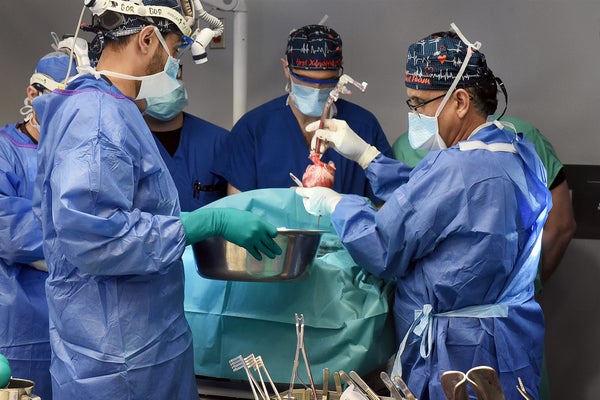
In an operating room at the University of Maryland Medical Center on September 20, 2023, surgeons transfer a genetically modified pig heart to the operative field for transplant.
University of Maryland School of Medicine
In world with so much urgent and depressing news, it can be hard to take a moment and reflect on all of the encouraging scientific and medical progress that has happened. But looking back at 2023, there was plenty on the health beat to be awed by.
From the arrival of the first safe and effective vaccines for a common respiratory disease to the first U.S. Food and Drug Administration–approved CRISPR gene editing treatment, these were some of the biggest stories in the health world this year.
New Weight-Loss Drugs Revealed New Tricks
On supporting science journalism.
If you're enjoying this article, consider supporting our award-winning journalism by subscribing . By purchasing a subscription you are helping to ensure the future of impactful stories about the discoveries and ideas shaping our world today.
A new generation of drugs that result in significant weight loss appeared on the scene a few years ago with dramatic effects. This past year we learned a lot more about other potential benefits of the drugs, which include Novo Nordisk’s Wegovy and Ozempic and Eli Lilly’s Mounjaro. These range from reducing the risk of heart attack or stroke to possibly treating addiction . But the medications come with side effects such as gastrointestinal problems and muscle loss. They’re not cheap, either—they can cost around $1,000 or more out of pocket—and it’s not clear whether insurance will cover them . Still, these drugs are driving significant interest as we continue to learn more about them.
The COVID Public Health Emergency Ended
The federal public health emergency put in place to combat the COVID pandemic ended on May 11. The end of the public health emergency marked the conclusion of a set of policies that made it easier and cheaper to access COVID tests, vaccines and treatments, as well as telehealth visits. Consumers must now obtain many of these things with coverage through private insurance, Medicare, or Medicaid or bear the cost themselves. SARS-CoV-2, the virus that causes COVID, continues to circulate and pose a threat to public health. But in May the World Health Organization declared that disease no longer constituted a public health emergency of international concern and said that it was time to transition to long-term management of the COVID pandemic.
We Got Closer to Xenotransplants
There’s an enormous need for organ transplants, but donor organs are in short supply. Improvements in transplant science have made more organs available and usable. Yet too many people still die waiting for one. Now some scientists are exploring another approach: transplanting organs from nonhuman animals . In the past year they have made significant progress in such “xenotransplants.” Following the first transplant of a genetically engineered pig heart into a human in early 2022, this year doctors completed the second such transplant . (Both surgeries were performed on a compassionate use basis because the recipients were terminally ill.) Sadly, the man who received the heart in the latest surgery died after six weeks, likely because his immune system rejected the organ. Other researchers completed successful xenotransplant experiments in people who had suffered brain death, and monkeys that received pig kidneys survived for up to two years . Scientists are hopeful that they can improve the procedures enough to test these techniques in clinical trials in people soon.
RSV Vaccines Finally Arrived
Respiratory syncytial virus (RSV) causes annoying coldlike symptoms in most people, yet in very young children or older adults the disease can be deadly. For decades scientists have tried to develop a vaccine to protect against RSV , but a series of disastrous clinical trials in the 1960s ended up making the illness more severe, leading to the deaths of two children. Researchers persisted, however, and as of this year, several safe and effective RSV vaccines were approved by the FDA to protect pregnant people and older adults. The agency also approved an antibody drug that protects children after they’re born.
The First CRISPR-Based Treatment Was Approved
Nearly a decade after it was first discovered, the gene editing method known as CRISPR is resulting in its first treatments. In December the FDA approved the first CRISPR-based treatment for sickle cell disease . The new therapy is known as exa-cel and made by the biotech companies Vertex Pharmaceuticals and CRISPR Therapeutics. It deactivates a faulty gene for the hemoglobin protein, which transports oxygen around the body. Without the treatment, the gene causes blood cells to develop a sicklelike shape, making them clog up blood vessels. The illness, which disproportionately affects Black people, causes debilitating pain and fatigue. The new treatment, as well as another gene therapy approved at the same time, prevented symptoms of the disease for a year in clinical trials. But longer follow-up is needed to see if there are any side effects, and the cost could make it hard for many people to access.
We Gained New Insight Into Long COVID
Even as the immediate danger of COVID has receded somewhat, tens of millions of people continue to be affected by long COVID—a cluster of symptoms such as fatigue, body aches and brain fog that linger long after an infection. The causes of long COVID are still mysterious, yet as Stephani Sutherland wrote in our March issue, it increasingly resembles a neurological disease . Not only does it cause cognitive problems with memory, attention, sleep and mood, but it also has symptoms such as pain and postexertional malaise—extreme fatigue after exercise—that seem to stem from the autonomic nervous system, the autopilot system that controls breathing and digestion, among other things. This new understanding could help guide treatments.
Chat-Based AI Systems Entered Medicine
When ChatGPT was released in November 2022, it caused ripples throughout numerous fields—and medicine was no exception. This chat-based artificial intelligence program made by the company OpenAI—along with large language models made by Google and others—is capable of generating text that convincingly mimics human writing. People have already begun to use these programs to diagnose medical conditions , and while the AIs appear surprisingly accurate in some early studies, doctors caution that they are not a substitute for professional medical care. Other people are turning to AI chatbots for therapy . Such apps could help meet the growing demand for mental health services, but as with using them for medical advice, experts urge caution.

First Face and Eye Transplant Was Completed
Xenotransplants weren’t the only groundbreaking type of transplant to occur this year. In May doctors in New York City completed the first partial face and whole-eye transplant in an Arkansas man who had suffered severe electrical burns while working as a lineman. While corneal transplants are routine, this was the first time an entire human eye was transplanted and remained healthy six months later, according to the transplant team. The recipient, 46-year-old Aaron James, has not regained sight in that eye, but doctors say the eye’s retinal tissue is intact, and there are signs it may be sending signals to the brain. The feat opens the door to restoring the appearance—and possibly, one day, the function—of people who have had traumatic eye injuries.
- U.S. Department of Health & Human Services

- Virtual Tour
- Staff Directory
- En Español
You are here
Nih research matters.
December 21, 2023
2023 NIH Research Highlights - Basic Research Insights
Noteworthy advances in fundamental research.
With NIH support, scientists across the United States and around the world conduct wide-ranging research to discover ways to enhance health, lengthen life and reduce illness and disability. Groundbreaking NIH-funded research often receives top scientific honors. In 2023, these honors included two NIH-supported scientists who received Nobel Prizes . Here’s just a small sample of the NIH-supported research accomplishments in 2023. Also see this year's Human Health Advances and Promising Medical Findings .
Printer-friendly version of full 2023 NIH Research Highlights
20231031-brain.jpg

Scientists build largest maps to date of cells in human brain
An international network of researchers created detailed cellular maps of human and nonhuman animal brains. The scientists created the most detailed cell atlas yet of the adult human brain. They also compared human and nonhuman primate brains and found gene activity patterns that were unique to humans. These and other findings could lead to future advances for a host of mental conditions and brain disorders.
20230825-sperm.jpg

Male contraceptive disables sperm
Researchers developed a compound that temporarily disabled mouse and human sperm. It worked by inhibiting an enzyme that sperm need in order to move. Treating male mice with the compound prevented pregnancies without affecting mating behavior. Male fertility returned to normal by 24 hours after treatment. The findings could potentially lead to a non-hormonal, on-demand contraceptive pill for men.
20231031-mrsa-GovD.jpg
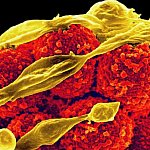
Immune boost may protect against multiple hospital-acquired infections
Traditional vaccines train the body to recognize a specific microbe. Researchers designed a novel type of vaccine that stimulated the innate immune system, the body's first line of defense against infection. The vaccine provided protection for mice against a wide range of bacteria and fungi. If effective in people, the approach could help prevent deaths from hospital-acquired infections.
2020314-depression.png

How psychedelic drugs may help with depression
Some psychedelic drugs are being tested as therapies for certain mental illnesses. These drugs work by binding receptors that promote plasticity—the brain's ability to form new connections. Researchers found that these compounds needed to cross nerve cell membranes to activate receptors inside cells. Activating the same receptors on the cell surface did not promote plasticity. The findings could lead to drugs that encourage brain plasticity without hallucinogenic effects.
20220110-gut.jpg

Gut microbes may affect motivation to exercise
Researchers found that gut microbes can affect levels of exercise in mice. Depleting the gut microbiome stopped dopamine increases in mice brains after exercise. It also caused the mice to exercise less and get exhausted more easily. Further experiments revealed how the gut microbes raise dopamine levels in the brain. The findings, if confirmed in humans, suggest strategies that might help encourage people to exercise.
Read more 2023 NIH Research Highlights: Human Health Advances
Connect with Us
- More Social Media from NIH
Thank you for visiting nature.com. You are using a browser version with limited support for CSS. To obtain the best experience, we recommend you use a more up to date browser (or turn off compatibility mode in Internet Explorer). In the meantime, to ensure continued support, we are displaying the site without styles and JavaScript.
- View all journals
- Explore content
- About the journal
- Publish with us
- Sign up for alerts
Articles in 2023
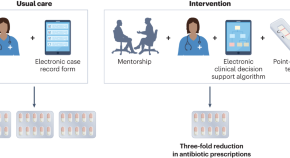
Tackling inappropriate antibiotic use in low-and middle-income countries
New data show that electronic clinical decision support systems integrated with point-of-care tests can lead to meaningful reductions in antibiotic use in children in low- and middle-income countries, without compromising health outcomes — but investment in human resources is crucial to their success.
- Sena Sayood
- Julia Bielicki
- Sumanth Gandra
Author Correction: Financial incentives for COVID-19 vaccines in a rural low-resource setting: a cluster-randomized trial
- Raymond Duch
- Edward Asiedu
- Philip Clarke
Author Correction: Cell-based versus corticosteroid injections for knee pain in osteoarthritis: a randomized phase 3 trial
- Ken Mautner
- Michael Gottschalk
- Hicham Drissi
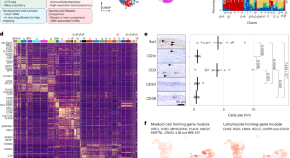
Multiomic spatial landscape of innate immune cells at human central nervous system borders
A single-cell spatial transcriptomic and proteomic study of immune cells in the human CNS border compartments reveals differences in CNS-associated macrophages across age, perturbation and disease.
- Roman Sankowski
- Patrick Süß
- Marco Prinz
Editorial Expression of Concern: Altered neuregulin 1–erbB4 signaling contributes to NMDA> receptor hypofunction in schizophrenia
- Chang-Gyu Hahn
- Hoau-Yan Wang
- Steven E Arnold
A decade of the Oesophageal Cancer Clinical and Molecular Stratification Consortium
- C. J. Peters
- R. C. Fitzgerald
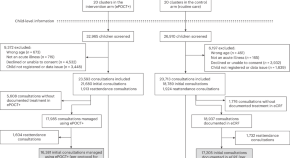
A digital health algorithm to guide antibiotic prescription in pediatric outpatient care: a cluster randomized controlled trial
A cluster randomized trial in Tanzania showed that the implementation of a decision support algorithm decreased antibiotic prescriptions to children considerably, without impacting clinical outcomes.
- Godfrey Kavishe
- Valérie D’Acremont
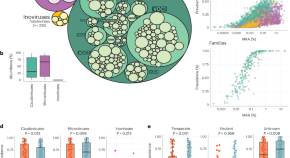
The infant gut virome is associated with preschool asthma risk independently of bacteria
Components of the gut virome of 1-year-old children are associated with increased risk of development of asthma later in life, probably through direct interaction between phages and the host immune system.
- Cristina Leal Rodríguez
- Shiraz A. Shah
- Jakob Stokholm

WHO cautions against non-sugar sweeteners
This year brought wins for artificial intelligence, genomics and gene editing, and breakthroughs in understanding diseases whose underpinnings have long eluded scientists. Here is our selection of critical developments that moved medicine forward in 2023.
- Karen O’Leary
Positive results in Alzheimer’s disease trials
An obesity drug for heart failure, diversifying the ‘reference’ genome, misinformation, mistrust and science, putting endometriosis on the map, base editors in the clinic, mounting evidence for perioperative immunotherapy, raising the bar for ai in cancer screening.

Seeing through the fog of long COVID
Art must be accessible and sustainable.
Governments need to invest in making assisted reproductive technology more accessible and equitable to counter staggering birth rate declines globally.
Author Correction: A joint international consensus statement for measuring quality of survival for patients with childhood cancer
- Rebecca J. van Kalsbeek
- Melissa M. Hudson
- Lisa Zwiers
Quick links
- Explore articles by subject
- Guide to authors
- Editorial policies
- 2023 IN REVIEW
7 medical breakthroughs that gave us hope in 2023
From gene therapy to Alzheimer’s treatment, predicting pancreatic cancer to pioneering reproduction methods, there were many promising discoveries in 2023 that will influence health and medicine

COVID-19 has continued to claim lives in 2023, killing more than 50 thousand patients in the United States alone and bringing the global death toll to almost seven million people . The pandemic has also created an epidemic of survivors who continue to suffer from long COVID. But it wasn’t all bad news in 2023.
With more people becoming immune against the virus, the World Health Organization decided, on May 5 , that COVID-19 no longer constitutes a public health emergency of international concern. Updated boosters of existing vaccines helped reduce the number of cases, hospitalizations, and deaths, and a new COVID vaccine from Novavax was approved this year.
Aside from COVID-19 vaccines, there were many other interesting and groundbreaking discoveries made this year, some of which are especially notable for their potential impact on health and medicine.
1. The world’s first CRISPR-based gene therapy becomes available
The world’s first CRISPR-based gene therapy was approved by drug regulators in the United Kingdom on November 16 , and the U.S. on December 8 . It treats sickle cell disease and beta thalassemia, genetic disorders that affect the red blood cells. Hemoglobin, found in red blood cells, carries oxygen around the body. The errors in hemoglobin genes create fragile red blood cells that cause a shortage of oxygen in the body, a condition known as anemia. Patients with sickle cell disease also suffer from infections and severe pain when sickled cells form clots and impede blood flow, while patients with beta thalassemia must receive blood transfusion every three to four weeks.
The newly approved gene therapy, named CASGEVY , corrects faulty hemoglobin genes in a patient’s bone marrow stem cells so they can produce functioning hemoglobin. A patient’s stem cells are harvested from their bone marrow, edited in a laboratory, and then infused back into the patient. A single treatment can potentially cure some patients for life.
Two inventors who fine-tuned CRISPR (short for “clustered regularly interspaced short palindromic repeats”) to work as a precise gene-editing tool, Emmanuelle Charpentier and Jennifer Doudna , were awarded the Nobel Prize in Chemistry just three years ago in 2020.

LIMITED TIME OFFER
This is just the first of dozens of potential treatments in development to treat other genetic diseases, cancer , or even infertility .
2. The first drug that slows down Alzheimer’s disease gets approved
The U.S. Food and Drug Administration approved the first drug for Alzheimer’s that targets one underlying cause of the disease . While the drug, Leqembi, isn't a cure or improve symptoms in late-stage disease, after 18 months of treatment it slows declines in memory and thinking by about 30 percent if the medicine is given in the early stage of disease.
Leqembi is a monoclonal antibody that works by targeting amyloid plaques in the brain that are a defining feature of Alzheimer’s disease. When abnormal levels of a naturally occurring protein, called beta amyloid, clump together to form sticky plaques in brain, they trigger inflammation and damage neuronal connections. Accumulation of amyloid plaques leads to loss of memory and thinking causing Alzheimer’s disease.
Clinical trials indicate that Leqembi removes amyloid plaques from the brain, which slows the progression of the disease.
3. Researchers produce healthy mice pups from two fathers; no female required
Yes, you read that right. Researchers from Japan presented evidence at a scientific conference that it is possible to produce healthy, fertile mice without an egg from a female mouse.
First, eggs were made from the stem cells derived from the skin cells of a male mouse. These eggs were fertilized with sperm of another male and then the fertilized egg was transferred into a female mouse where it grew and matured.
Although just seven out of more than 600 implanted embryos developed into baby mice, the pups grew normally and were fertile as adults.
It is not yet known if the mouse pups will develop exactly like those born through conventional breeding. These findings have not yet been published in a peer reviewed journal and similar preliminary steps have so far failed in humans .
You May Also Like

She had a severe brain injury—so her husband turned to an unprecedented therapy

A new blood test could speed up Alzheimer’s diagnoses. Will it lead to better treatments?

Meet Sturgeon, the AI tool that helps doctors identify brain tumors faster than ever
4. scientists map all the connections in an insect brain.
Scientists have produced the first complete brain-wiring diagram of an insect brain . This may not sound impressive but the brain, even that of a fruit fly, contains vast networks of interconnected neurons called the connectome.
Until now, only the brains of a roundworm, a sea squirt, and a marine worm have been completely mapped; each of which contains just a couple of hundred connections.
But a complete map of the connectome of a fruit fly larva reveals it contains more than 3,000 neurons and more than half a million connections between them. Developing this map took an international team of scientists more than five years. Although a fruit fly brain is much simpler than that of humans, the techniques developed will help map more complex brains in the future.
The neural circuits In the fruit fly brain look similar to neural networks used in machine learning. Understanding the similarities and complexities of the fly brain connectome can help to decipher how the human brain works and how neurological diseases develop. It can also lead to the development of new machine learning methods and more efficient artificial intelligence systems.
5. Pigment-producing cells get "stuck" causing gray hairs
Scientists show that when pigment-producing cells , called melanocytes, get stuck in an immature state, they fail to develop their blonde, brown, red, or black, hair color. This arrested state leads to graying hairs. New hair grows from follicles, found in the skin, where melanocytes also reside.
The scientists at New York University observed single melanocyte stem cells migrate up and down the individual hair folicle of mice over two years. To their surprise, they found that melanocyte stem cells can switch back and forth from gray immature stem cells to mature colored cells as they traverse up and down during the life cycle of the hair. But as hair ages, the melanocyte stem cells get sluggish after multiple cycles and become trapped near the base of the hair as immature melanocytes. With no pigment being produced, the hair turns gray.
6. Bacteria shown to help cancer cells spread more aggressively
Scientists have found that some bacteria that are frequently found in many gastrointestinal tract tumors directly help cancer cells evade the body’s immune response.
Not only do these bacteria cooperate with tumor cells to promote cancer progression, they also help them spread more rapidly by breaking down anticancer drugs and causing the treatment to fail .
This research suggests that some anticancer drugs are effective because they also kill the tumor dwelling bacteria . Understanding how the tumor's microenvironment affects its survival and progression can open new doors of treating cancer.
7. AI identifies people at the highest risk of pancreatic cancer
A new artificial intelligence (AI) tool can predict pancreatic cancer up to three years before actual diagnosis, by identifying specific patterns of conditions that occurred in patients’ health records.
Pancreatic cancer is rare but it is the third largest cause of cancer-related deaths. It is so deadly because it is generally detected in the late stages when the disease has already spread to other areas of body.
Symptoms of early stage pancreatic cancer are easily misdiagnosed, but many patients could live longer if the cancer was detected early. That led scientists to train an AI algorithm on the medical records of 6.2 million people from Denmark spanning 41 years to detect the patterns hidden in the records of 24,000 patients who later developed pancreatic cancer.
In the medical records, each disease is recorded with a code. The AI model analyzed the combinations of these disease codes and the timing of their occurrence. By comparing specific sequences of conditions that preceded a diagnosis of pancreatic cancer, the AI model learned to identify those at greatest risk for the disease.
The scientists then tested the AI tool by analyzing the records of nearly 3 million U.S. veterans spanning 21 years. The computer algorithm correctly identified almost 4,000 individuals, up to three years before they were actually diagnosed with pancreatic cancer. The study shows that AI models can be as accurate as genetic testing in predicting the risk of pancreatic cancer. Because pancreatic cancer is so rare, genetic screening is currently recommended only for high risk individuals, or with those with a family history of the disease.
Related Topics
- GENE THERAPY
- ANIMAL REPRODUCTION
- ARTIFICIAL INTELLIGENCE
- NEUROSCIENCE
- ALZHEIMER'S DISEASE

What your biological age can reveal about your health

What are the early warning signs of CTE? New clues emerge

Dementia has no cure. But there’s hope for better care.

We know a lot less about hair loss in women than in men. Here’s why.

Ozempic and Mounjaro have another benefit: treating inflammation
- Terms of Use
- Privacy Policy
- Your US State Privacy Rights
- Children's Online Privacy Policy
- Interest-Based Ads
- About Nielsen Measurement
- Do Not Sell or Share My Personal Information
- Nat Geo Home
- Attend a Live Event
- Book a Trip
- Inspire Your Kids
- Shop Nat Geo
- Visit the D.C. Museum
- Learn About Our Impact
- Support Our Mission
- Advertise With Us
- Customer Service
- Renew Subscription
- Manage Your Subscription
- Work at Nat Geo
- Sign Up for Our Newsletters
- Contribute to Protect the Planet
Copyright © 1996-2015 National Geographic Society Copyright © 2015-2024 National Geographic Partners, LLC. All rights reserved

IMAGES
COMMENTS
With NIH support, scientists across the United States and around the world conduct wide-ranging research to discover ways to enhance health, lengthen life and reduce illness and disability. Groundbreaking NIH-funded research often receives top scientific honors. In 2023, these honors included two NIH-supported scientists who received Nobel ...
Here are some of the biggest medical advances in 2023. New treatments include the first CRISPR gene-editing therapy, an Alzheimer’s drug and RSV vaccines
Nature Medicine asks leading researchers to name their top clinical trial for 2023, from cervical and prostate cancer screening to new drugs for Parkinson’s disease and Alzheimer’s disease.
From new vaccines to the first drugs of their kind for hard-to-treat disorders, 2023 has been a year full of medical breakthroughs. They offer opportunities for people to protect themselves from diseases, slow down the effects of others and even incorporate artificial intelligence into cancer diagnoses.
2023 NIH Research Highlights - Human Health Advances Disease Prevention, Diagnosis and Treatment With NIH support, scientists across the United States and around the world conduct wide-ranging research to discover ways to enhance health, lengthen life and reduce illness and disability.
From the arrival of the first safe and effective vaccines for a common respiratory disease to the first U.S. Food and Drug Administration–approved CRISPR gene editing treatment, these were some of...
With NIH support, scientists across the United States and around the world conduct wide-ranging research to discover ways to enhance health, lengthen life and reduce illness and disability. Groundbreaking NIH-funded research often receives top scientific honors. In 2023, these honors included two NIH-supported scientists who received Nobel ...
Here is our selection of critical developments that moved medicine forward in 2023.
From gene therapy to Alzheimer’s treatment, predicting pancreatic cancer to pioneering reproduction methods, there were many promising discoveries in 2023 that will influence...
Discoveries about high blood pressure, atrial fibrillation and more made the American Heart Association’s list of the most significant advances against heart disease and stroke in 2023.